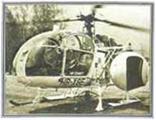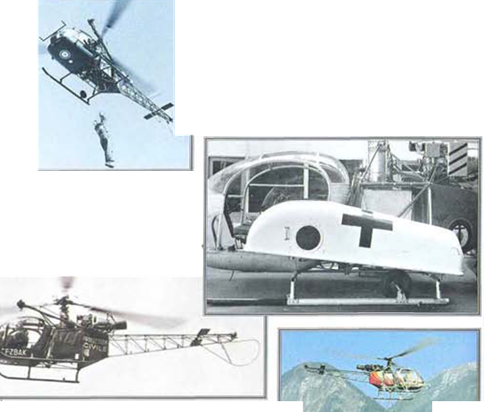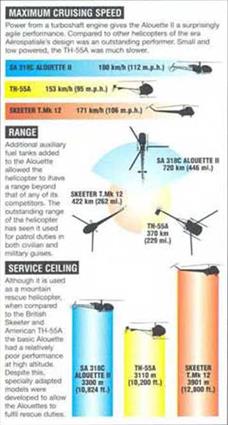Alouette II
• High altitude • Air ambulance • Excellent handling

 Sud-Est, one of the forerunners of
Sud-Est, one of the forerunners of
Aerospatiale, combined Turbomeca’s new Artouste turbine with a gearbox adapted from the Sikorsky S-55 to produce power for the Alouette. It flew for the first time in March 1955, and within three months the machine had set a new helicopter altitude record of 8209 m (26,925 ft). Two years later an Alouette raised the record to 10984 m (36,028 ft.). This altitude performance made the aircraft a natural candidate for mountain rescuos.
 |
 |
Airborne ambulance ►

 Once retrieved from the mountain, survivors are flown to hospital m special fuselage stretchers.
Once retrieved from the mountain, survivors are flown to hospital m special fuselage stretchers.
A The search is on
Pilots often look for the survivors themselves, exploiting the excellent visibility from the Alouotto’s cockpit.
Star performer ►
Demonstrating the capabilities of the helicopter is this example, lifting a large balloon as part of a publicity stunt. Crews find the helicopter a delight to fly.
FACTS AND
Tho Alouette II first flow on 12 March 1955: French certification on 2 Мзу 1956 cleared the way for production.
Germany has used the helicopter for more than 25 years without any crashes.
Because of the shape of the fuselago tho helicopter is known as ‘bug-eye.*
FIGURES
Options available for the helicopter include skid landing gear, floats or a wheelod undorcarriage.
In the rescuo role the Alouette has a 120-kg (264-lb.) capable hoist.
^ Many civilian oxamplos operating today are ex-military machines.
 |
|
![]()


![]()
![]()
![]()
![]()

![]()

![]()
![]()

![]()
![]()
![]()

![]()

Even Ivfore flight testing h;u! Ічч-п completed, the Alouette II was showing its abilities as a mountain rescue aircT. ill The second prototype Alouette II was in the Alps lot performance tests in July 1956 when the test team learned that a clinilier was dying after liaving a heart attack in the Valid Mountain refuge, one of die highest in Enrol*’ at )56J ill (1 1.^07 ft.)
Tlic liisj attempt at a rescue was unsuccessful, I ни the second worked, within five minutes of landing the helicopter had
Help from above
transported the ilnnlier to hospual in Clumonix. thereby saving his life.
At the Ixrginning of 1957 two Alouette* t arried c Hit a similar rescue, retrieving six mountain guides, and two pilots of an rescue helicopter which had crashed, from the same refuge
Since tlien the Alouette II and its high altitude version, the lama, have carried out mail) mountain rescues, retrieving stranded climlH-Ts from places that would not have Інч*п reachable by any other means
Aerospatiale











